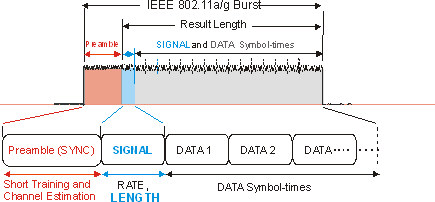Symbols (802.11a/g/j/p OFDM)
Symbols is the number of DATA symbols transmitted in the OFDM Orthogonal Frequency Division Multiplexing: OFDM employs multiple overlapping radio frequency carriers, each operating at a carefully chosen frequency that is Orthogonal to the others, to produce a transmission scheme that supports higher bit rates due to parallel channel operation. OFDM is an alternative tranmission scheme to DSSS and FHSS. burst.
-
The Symbols data is the number of DATA symbols within the burst after the SIGNAL symbol-time. The number of DATA symbols is obtained from the SIGNAL symbol - LENGTH data.
-
Symbol data is not available (N/A).
OFDM IEEE 802.11a/g/j/p SIGNAL Symbol
The following figure shows the IEEE Institute of Electrical and Electronics Engineers. A US-based membership organisation that includes engineers, scientists, and students in electronics and related fields. The IEEE developed the 802 series wired and wireless LAN standards. Visit the IEEE at http://www.ieee.org 802.11a/g/j/p OFDM burst structure, which contains the Preamble symbols followed by the SIGNAL symbol time and Data symbol times. The SIGNAL symbol contains the RATE and LENGTH fields. The LENGTH field provides the number of DATA symbols within the burst (This is the Symbols Error Summary data result). The encoding of the SIGNAL, single OFDM symbol, is performed with BPSK Binary phase shift keying - A type of phase modulation using 2 distinct carrier phases to signal ones and zeros. modulation of the subcarriers.

For IEEE 802.11a/g/j/p signals, the and trace data displays shows the number of symbols specified by the Result Length parameter and not the Symbols data result.
See Also
Result Length (802.11a/g/j/p OFDM)
Measurement Interval and Offset (802.11a/g/j/p OFDM)
